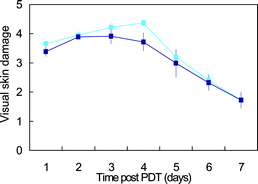Light fractionation does not enhance the efficacy of methyl 5-aminolevulinate mediated photodynamic therapy in normal mouse skin†
Abstract
Previous work demonstrated that fractionated illumination using two fractions separated by a dark interval of 2 h, significantly enhanced the clinical efficacy of photodynamic therapy (PDT) with

- This article is part of the themed collection: Photodynamic Therapy and Photodetection

 Please wait while we load your content...
Please wait while we load your content...